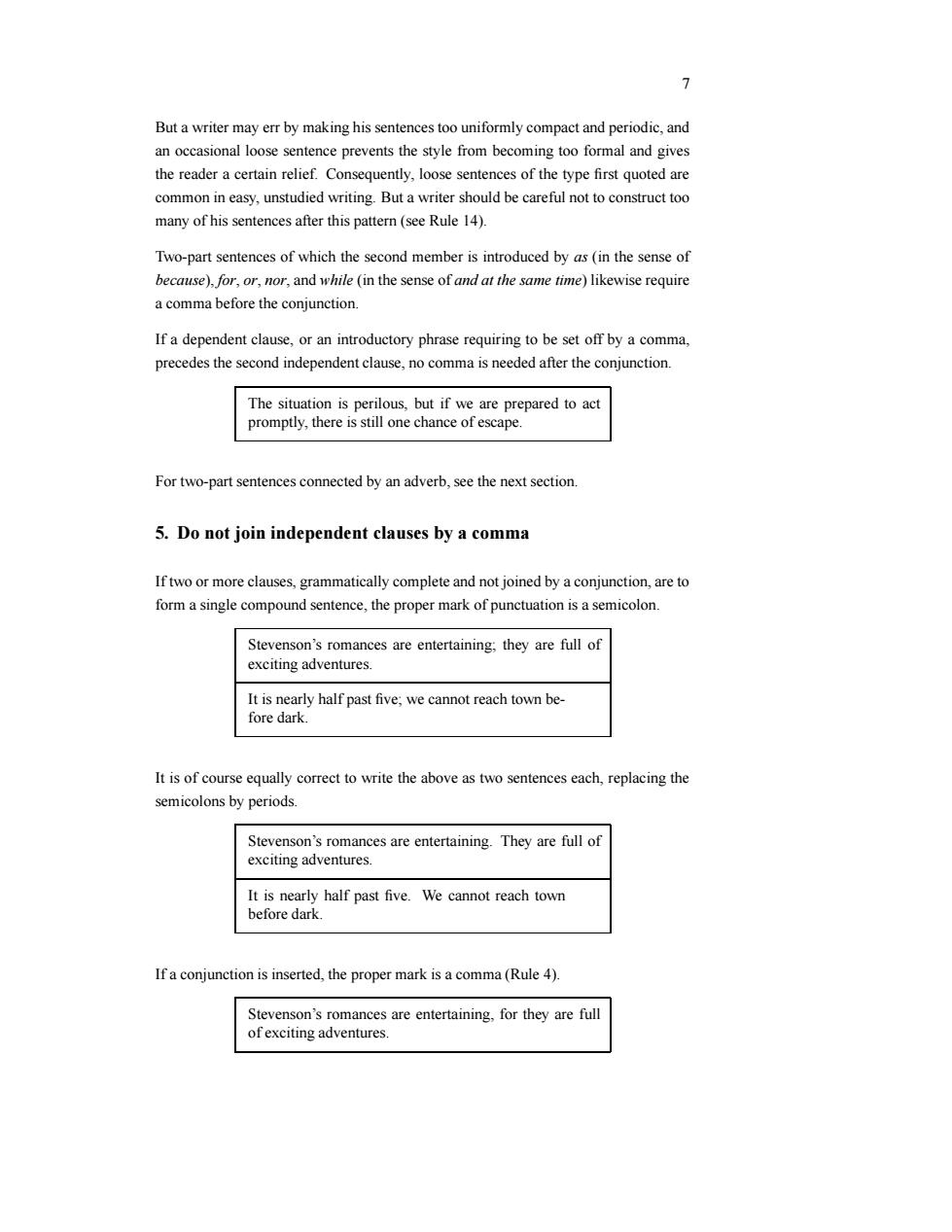正在加载图片...

7 But a writer may err by making his sentences too uniformly compact and periodic,and an occasional loose sentence prevents the style from becoming too formal and gives the reader a certain relief.Consequently,loose sentences of the type first quoted are common in easy,unstudied writing.But a writer should be careful not to construct too many of his sentences after this pattern(see Rule 14). Two-part sentences of which the second member is introduced by as(in the sense of because),for,or,nor,and while (in the sense of and at the same time)likewise require a comma before the conjunction. If a dependent clause,or an introductory phrase requiring to be set off by a comma, precedes the second independent clause,no comma is needed after the conjunction. The situation is perilous,but if we are prepared to act promptly,there is still one chance of escape. For two-part sentences connected by an adverb,see the next section. 5.Do not join independent clauses by a comma If two or more clauses,grammatically complete and not joined by a conjunction,are to form a single compound sentence,the proper mark of punctuation is a semicolon. Stevenson's romances are entertaining;they are full of exciting adventures. It is nearly half past five;we cannot reach town be- fore dark It is of course equally correct to write the above as two sentences each,replacing the semicolons by periods. Stevenson's romances are entertaining.They are full of exciting adventures. It is nearly half past five.We cannot reach town before dark. If a conjunction is inserted,the proper mark is a comma(Rule 4). Stevenson's romances are entertaining,for they are full of exciting adventures.7 But a writer may err by making his sentences too uniformly compact and periodic, and an occasional loose sentence prevents the style from becoming too formal and gives the reader a certain relief. Consequently, loose sentences of the type first quoted are common in easy, unstudied writing. But a writer should be careful not to construct too many of his sentences after this pattern (see Rule 14). Two-part sentences of which the second member is introduced by as (in the sense of because), for, or, nor, and while (in the sense of and at the same time) likewise require a comma before the conjunction. If a dependent clause, or an introductory phrase requiring to be set off by a comma, precedes the second independent clause, no comma is needed after the conjunction. The situation is perilous, but if we are prepared to act promptly, there is still one chance of escape. For two-part sentences connected by an adverb, see the next section. 5. Do not join independent clauses by a comma If two or more clauses, grammatically complete and not joined by a conjunction, are to form a single compound sentence, the proper mark of punctuation is a semicolon. Stevenson’s romances are entertaining; they are full of exciting adventures. It is nearly half past five; we cannot reach town before dark. It is of course equally correct to write the above as two sentences each, replacing the semicolons by periods. Stevenson’s romances are entertaining. They are full of exciting adventures. It is nearly half past five. We cannot reach town before dark. If a conjunction is inserted, the proper mark is a comma (Rule 4). Stevenson’s romances are entertaining, for they are full of exciting adventures